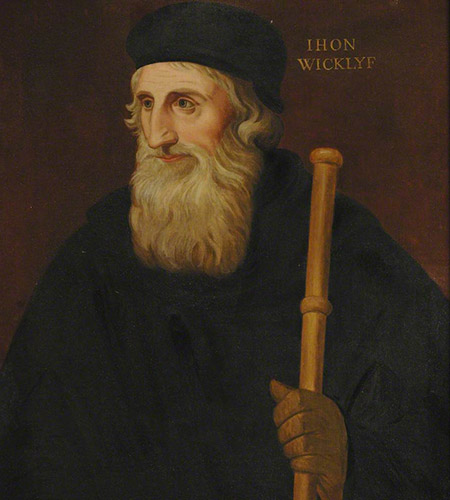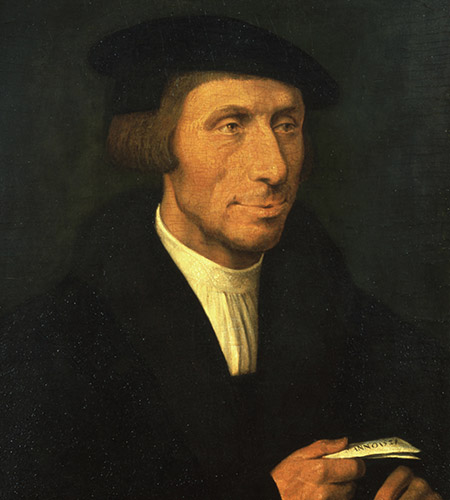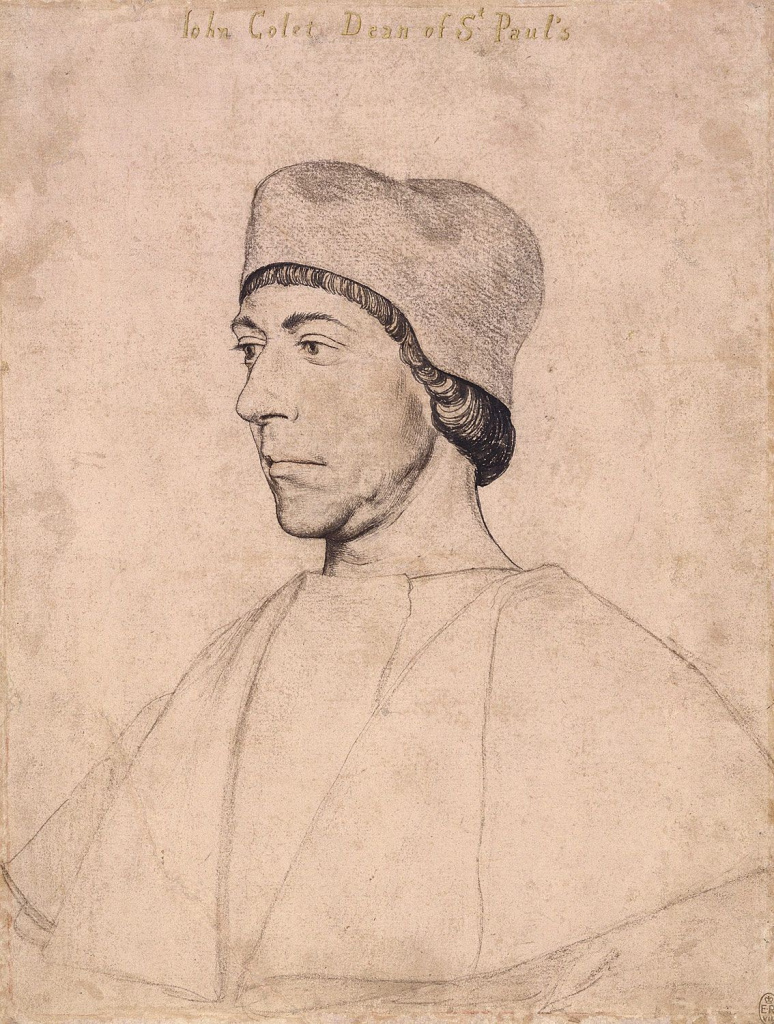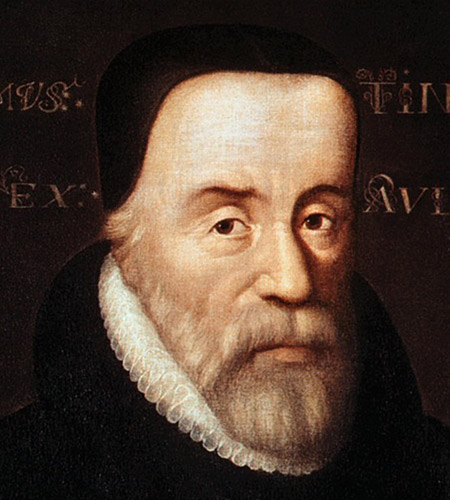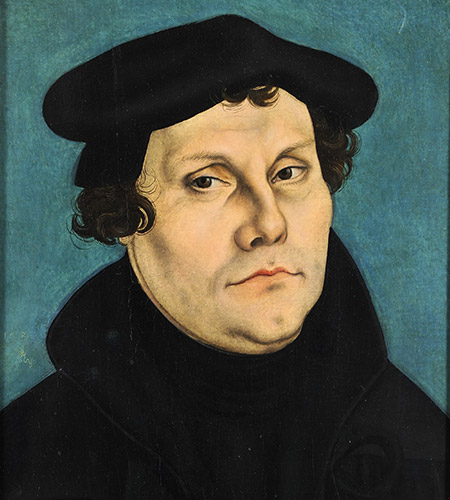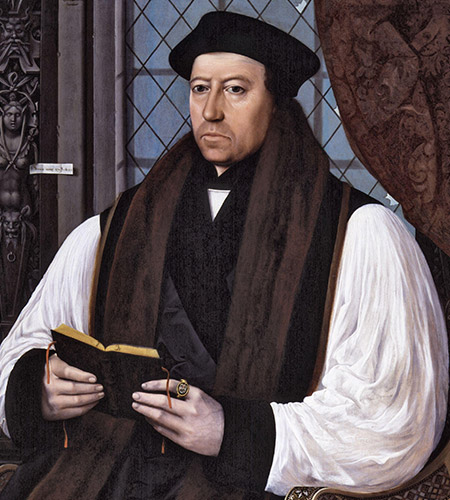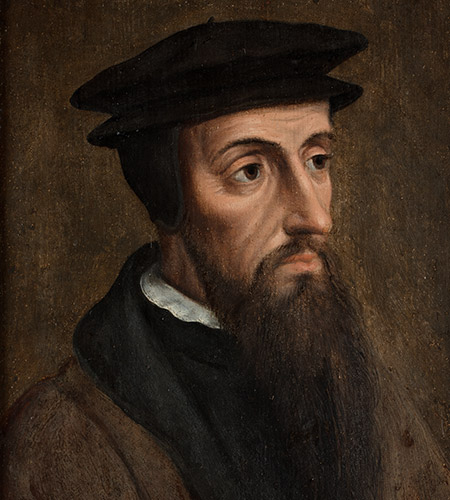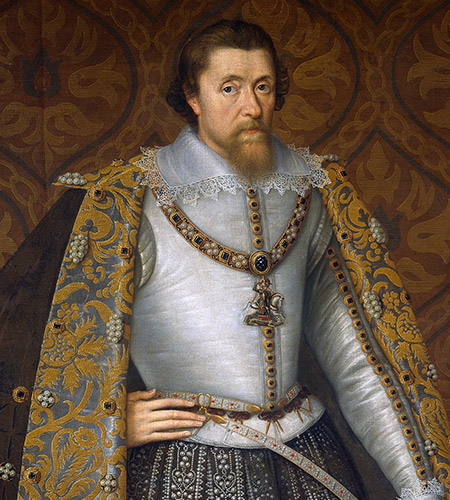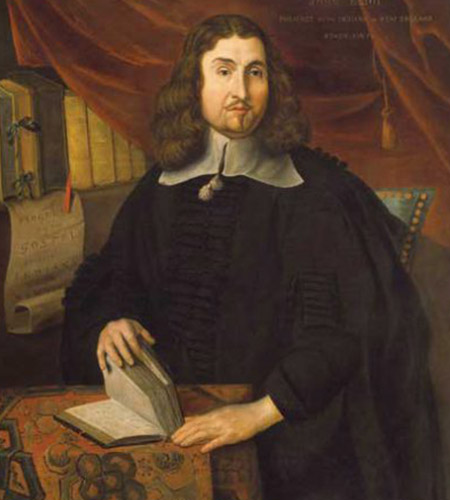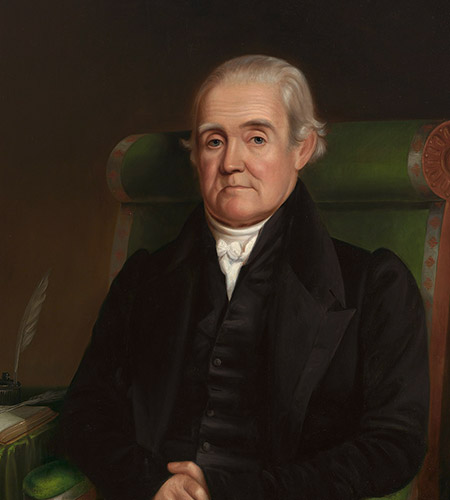English Bible History
thousands of years ago, as briefly outlined in our Timeline of Bible Translation History.
The History of The English Bible &
The History of The Christian Church Meet In The Protestant Reformation
In 1496, John Colet, another Oxford professor and the son of the Mayor of London, started reading the New Testament in Greek and translating it into English for his students at Oxford, and later for the public at Saint Paul’s Cathedral in London.
The people were so hungry to hear the Word of God in a language they could understand, that within six months there were 20,000 people packed in the church and at least that many outside trying to get in! (Sadly, while the enormous and beautiful Saint Paul’s Cathedral remains the main church in London today, as of 2003, typical Sunday morning worship attendance is only around 200 people… and most of them are tourists). Fortunately for Colet, he was a powerful man with friends in high places, so he amazingly managed to avoid execution.
Luther, who would be exiled in the months following the Diet of Worms Council in 1521 that was designed to martyr him, would translate the New Testament into German for the first time from the 1516 Greek-Latin New Testament of Erasmus, and publish it in September of 1522. Luther also published a German Pentateuch in 1523, and another edition of the German New Testament in 1529. In the 1530’s he would go on to publish the entire Bible in German.
William Tyndale wanted to use the same 1516 Erasmus text as a source to translate and print the New Testament in English for the first time in history. Tyndale showed up on Luther’s doorstep in Germany in 1525, and by year’s end had translated the New Testament into English. Tyndale had been forced to flee England, because of the wide-spread rumor that his English New Testament project was underway, causing inquisitors and bounty hunters to be constantly on Tyndale’s trail to arrest him and prevent his project. God foiled their plans, and in 1525-1526 the Tyndale New Testament became the first printed edition of the scripture in the English language. Subsequent printings of the Tyndale New Testament in the 1530’s were often elaborately illustrated.
They were burned as soon as the Bishop could confiscate them, but copies trickled through and actually ended up in the bedroom of King Henry VIII. The more the King and Bishop resisted its distribution, the more fascinated the public at large became. The church declared it contained thousands of errors as they torched hundreds of New Testaments confiscated by the clergy, while in fact, they burned them because they could find no errors at all. One risked death by burning if caught in mere possession of Tyndale’s forbidden books.
Having God’s Word available to the public in the language of the common man, English, would have meant disaster to the church. No longer would they control access to the scriptures. If people were able to read the Bible in their own tongue, the church’s income and power would crumble. They could not possibly continue to get away with selling indulgences (the forgiveness of sins) or selling the release of loved ones from a church-manufactured “Purgatory”. People would begin to challenge the church’s authority if the church were exposed as frauds and thieves. The contradictions between what God’s Word said, and what the priests taught, would open the public’s eyes and the truth would set them free from the grip of fear that the institutional church held. Salvation through faith, not works or donations, would be understood. The need for priests would vanish through the priesthood of all believers. The veneration of church-canonized Saints and Mary would be called into question. The availability of the scriptures in English was the biggest threat imaginable to the wicked church. Neither side would give up without a fight.
Today, there are only two known copies left of Tyndale’s 1525-26 First Edition. Any copies printed prior to 1570 are extremely valuable. Tyndale’s flight was an inspiration to freedom-loving Englishmen who drew courage from the 11 years that he was hunted. Books and Bibles flowed into England in bales of cotton and sacks of flour. Ironically, Tyndale’s biggest customer was the King’s men, who would buy up every copy available to burn them… and Tyndale used their money to print even more! In the end, Tyndale was caught: betrayed by an Englishman that he had befriended.
Tyndale was incarcerated for 500 days before he was strangled and burned at the stake in 1536. Tyndale’s last words were, “Oh Lord, open the King of England’s eyes”. This prayer would be answered just three years later in 1539, when King Henry VIII finally allowed, and even funded, the printing of an English Bible known as the “Great Bible”. But before that could happen…
The New Testament was completed in 1557, and the complete Bible was first published in 1560. It became known as the Geneva Bible. Due to a passage in Genesis describing the clothing that God fashioned for Adam and Eve upon expulsion from the Garden of Eden as “Breeches” (an antiquated form of “Britches”), some people referred to the Geneva Bible as the Breeches Bible.
The Geneva Bible was the first Bible to add numbered verses to the chapters, so that referencing specific passages would be easier. Every chapter was also accompanied by extensive marginal notes and references so thorough and complete that the Geneva Bible is also considered the first English “Study Bible”. William Shakespeare quotes hundreds of times in his plays from the Geneva translation of the Bible.
The Geneva Bible became the Bible of choice for over 100 years of English speaking Christians. Between 1560 and 1644 at least 144 editions of this Bible were published. Examination of the 1611 King James Bible shows clearly that its translators were influenced much more by the Geneva Bible, than by any other source. The Geneva Bible itself retains over 90% of William Tyndale’s original English translation. The Geneva in fact, remained more popular than the King James Version until decades after its original release in 1611! The Geneva holds the honor of being the first Bible taken to America, and the Bible of the Puritans and Pilgrims. It is truly the “Bible of the Protestant Reformation.” Strangely, the famous Geneva Bible has been out-of-print since 1644, so the only way to obtain one is to either purchase an original printing of the Geneva Bible, or a less costly facsimile reproduction of the original 1560 Geneva Bible.
With the end of Queen Mary’s bloody reign, the reformers could safely return to England. The Anglican Church, now under Queen Elizabeth I, reluctantly tolerated the printing and distribution of Geneva version Bibles in England.
The marginal notes, which were vehemently against the institutional Church of the day, did not rest well with the rulers of the day. Another version, one with a less inflammatory tone was desired, and the copies of the Great Bible were getting to be decades old. In 1568, a revision of the Great Bible known as the Bishop’s Bible was introduced. Despite 19 editions being printed between 1568 and 1606, this Bible, referred to as the “rough draft of the King James Version”, never gained much of a foothold of popularity among the people. The Geneva may have simply been too much to compete with.
By the 1580’s, the Roman Catholic Church saw that it had lost the battle to suppress the will of God: that His Holy Word be available in the English language. In 1582, the Church of Rome surrendered their fight for “Latin only” and decided that if the Bible was to be available in English, they would at least have an official Roman Catholic English translation. And so, using the corrupt and inaccurate Latin Vulgate as the only source text, they went on to publish an English Bible with all the distortions and corruptions that Erasmus had revealed and warned of 75 years earlier. Because it was translated at the Roman Catholic College in the city of Rheims, it was known as the Rheims New Testament (also spelled Rhemes). The Douay Old Testament was translated by the Church of Rome in 1609 at the College in the city of Douay (also spelled Doway & Douai). The combined product is commonly referred to as the “Doway/Rheims” Version. In 1589, Dr. William Fulke of Cambridge published the “Fulke’s Refutation”, in which he printed in parallel columns the Bishops Version along side the Rheims Version, attempting to show the error and distortion of the Roman Church’s corrupt compromise of an English version of the Bible.
A typographical discrepancy in Ruth 3:15 rendered a pronoun “He” instead of “She” in that verse in some printings. This caused some of the 1611 First Editions to be known by collectors as “He” Bibles, and others as “She” Bibles. Starting just one year after the huge 1611 pulpit-size King James Bibles were printed and chained to every church pulpit in England; printing then began on the earliest normal-size printings of the King James Bible. These were produced so individuals could have their own personal copy of the Bible.
Protestants today are largely unaware of their own history, and unaware of the Geneva Bible (which is textually 95% the same as the King James Version, but 50 years older than the King James Version, and not influenced by the Roman Catholic Rheims New Testament that the King James translators admittedly took into consideration). Nevertheless, the King James Bible turned out to be an excellent and accurate translation, and it became the most printed book in the history of the world, and the only book with one billion copies in print. In fact, for over 250 years…until the appearance of the English Revised Version of 1881-1885…the King James Version reigned without much of a rival. One little-known fact, is that for the past 250 years, all “King James Version” Bibles published anywhere by any publisher are actually Blaney’s 1769 Revised Oxford Edition of the 1611 King James Bible. The original “1611” preface is almost always deceivingly included by modern Bible publishing companies, and no mention of the fact that it is really the 1769 version is to be found, because that might hurt sales among those imagining that they are reading the original 1611 version.
The only way to obtain a true, unaltered, 1611 version is to either purchase an original pre-1769 printing of the King James Bible, or a less costly facsimile reproduction of the original 1611 King James Bible. A first edition facsimile reproduction of Blaney’s 1769 Revised Oxford Edition of the 1611 King James Bible is also available, which exemplifies the 20,000 spelling and punctuation changes and over 400 wording changes made to the original 1611 to 1768 King James Bible, when compared to King James Bibles published between 1769 and today.
The original 1611 King James contained the Apocrypha, and King James threatened anyone who dared to print the Bible without the Apocrypha with heavy fines and a year in jail. Only for the last 120 years has the Protestant Church rejected these books, and removed them from their Bibles. This has left most modern-day Christians believing the popular myth that there is something “Roman Catholic” about the Apocrypha. There is, however, no truth in that myth, and no widely-accepted reason for the removal of the Apocrypha in the 1880’s has ever been officially issued by a mainline Protestant denomination.
The Americans responded to England’s E.R.V. Bible by publishing the nearly-identical American Standard Version (A.S.V.) in 1901. It was also widely-accepted and embraced by churches throughout America for many decades as the leading modern-English version of the Bible. In the 1971, it was again revised and called New American Standard Version Bible (often referred to as the N.A.S.V. or N.A.S.B. or N.A.S.). This New American Standard Bible is considered by nearly all evangelical Christian scholars and translators today, to be the most accurate, word-for-word translation of the original Greek and Hebrew scriptures into the modern English language that has ever been produced. It remains the most popular version among theologians, professors, scholars, and seminary students today. Some, however, have taken issue with it because it is so direct and literal a translation (focused on accuracy), that it does not flow as easily in conversational English.
For this reason, in 1973, the New International Version (N.I.V.) was produced, which was offered as a “dynamic equivalent” translation into modern English. The N.I.V. was designed not for “word-for-word” accuracy, but rather, for “phrase-for-phrase” accuracy, and ease of reading even at a Junior High-School reading level. It was meant to appeal to a broader (and in some instances less-educated) cross-section of the general public. Critics of the N.I.V. often jokingly refer to it as the “Nearly Inspired Version”, but that has not stopped it from becoming the best-selling modern-English translation of the Bible ever published.
In 1982, Thomas Nelson Publishers produced what they called the “New King James Version”. Their original intent was to keep the basic wording of the King James to appeal to King James Version loyalists, while only changing the most obscure words and the Elizabethan “thee, thy, thou” pronouns. This was an interesting marketing ploy, however, upon discovering that this was not enough of a change for them to be able to legally copyright the result, they had to make more significant revisions, which defeated their purpose in the first place. It was never taken seriously by scholars, but it has enjoyed some degree of public acceptance, simply because of its clever “New King James Version” marketing name.
In 2002, a major attempt was made to bridge the gap between the simple readability of the N.I.V., and the extremely precise accuracy of the N.A.S.B. This translation is called the English Standard Version (E.S.V.) and is rapidly gaining popularity for its readability and accuracy. The 21st Century will certainly continue to bring new translations of God’s Word in the modern English language.
As Christians, we must be very careful to make intelligent and informed decisions about what translations of the Bible we choose to read. On the liberal extreme, we have people who would give us heretical new translations that attempt to change God’s Word to make it politically correct. One example of this, which has made headlines recently is the Today’s New International Version (T.N.I.V.) which seeks to remove all gender-specific references in the Bible whenever possible! Not all new translations are good… and some are very bad.
But equally dangerous, is the other extreme… of blindly rejecting ANY English translation that was produced in the four centuries that have come after the 1611 King James. We must remember that the main purpose of the Protestant Reformation was to get the Bible out of the chains of being trapped in an ancient language that few could understand, and into the modern, spoken, conversational language of the present day. William Tyndale fought and died for the right to print the Bible in the common, spoken, modern English tongue of his day… as he boldly told one official who criticized his efforts, “If God spare my life, I will see to it that the boy who drives the plowshare knows more of the scripture than you, Sir!”
Will we now go backwards, and seek to imprison God’s Word once again exclusively in ancient translations? Clearly it is not God’s will that we over-react to SOME of the bad modern translations, by rejecting ALL new translations and “throwing the baby out with the bathwater”. The Word of God is unchanging from generation to generation, but language is a dynamic and ever-changing form of communication. We therefore have a responsibility before God as Christians to make sure that each generation has a modern translation that they can easily understand, yet that does not sacrifice accuracy in any way. Let’s be ever mindful that we are not called to worship the Bible. That is called idolatry. We are called to worship the God who gave us the Bible, and who preserved it through the centuries of people who sought to destroy it.
We are also called to preserve the ancient, original English translations of the Bible… and that is what we do here at WWW.GREATSITE.COM
Consider the following textual comparison of the earliest English translations of John 3:16, as shown in the English Hexapla Parallel New Testament:
- 1st Ed. King James (1611): “For God so loued the world, that he gaue his only begotten Sonne: that whosoeuer beleeueth in him, should not perish, but haue euerlasting life.”
- Rheims (1582): “For so God loued the vvorld, that he gaue his only-begotten sonne: that euery one that beleeueth in him, perish not, but may haue life euerlasting”
- Geneva (1560): “For God so loueth the world, that he hath geuen his only begotten Sonne: that none that beleue in him, should peryshe, but haue euerlasting lyfe.”
- Great Bible (1539): “For God so loued the worlde, that he gaue his only begotten sonne, that whosoeuer beleueth in him, shulde not perisshe, but haue euerlasting lyfe.”
- Tyndale (1534): “For God so loveth the worlde, that he hath geven his only sonne, that none that beleve in him, shuld perisshe: but shuld have everlastinge lyfe.”
- Wycliff (1380): “for god loued so the world; that he gaf his oon bigetun sone, that eche man that bileueth in him perisch not: but haue euerlastynge liif,”
- Anglo-Saxon Proto-English Manuscripts (995 AD): “God lufode middan-eard swa, dat he seade his an-cennedan sunu, dat nan ne forweorde de on hine gely ac habbe dat ece lif.”
Timeline of Bible Translation History
1,400 BC: The first written Word of God: The Ten Commandments delivered to Moses.
500 BC: Completion of All Original Hebrew Manuscripts which make up The 39 Books of the Old Testament.
200 BC: Completion of the Septuagint Greek Manuscripts which contain The 39 Old Testament Books AND 14 Apocrypha Books.
1st Century AD: Completion of All Original Greek Manuscripts which make up The 27 Books of the New Testament.
315 AD: Athenasius, the Bishop of Alexandria, identifies the 27 books of the New Testament which are today recognized as the canon of scripture.
382 AD: Jerome’s Latin Vulgate Manuscripts Produced which contain All 80 Books (39 Old Test. + 14 Apocrypha + 27 New Test).
500 AD: Scriptures have been Translated into Over 500 Languages.
600 AD: LATIN was the Only Language Allowed for Scripture.
995 AD: Anglo-Saxon (Early Roots of English Language) Translations of The New Testament Produced.
1384 AD: Wycliffe is the First Person to Produce a (Hand-Written) manuscript Copy of the Complete Bible; All 80 Books.
1455 AD: Gutenberg Invents the Printing Press; Books May Now be mass-Produced Instead of Individually Hand-Written. The First Book Ever Printed is Gutenberg’s Bible in Latin.
1516 AD: Erasmus Produces a Greek/Latin Parallel New Testament.
1522 AD: Martin Luther’s German New Testament.
1526 AD: William Tyndale’s New Testament; The First New Testament printed in the English Language.
1535 AD: Myles Coverdale’s Bible; The First Complete Bible printed in the English Language (80 Books: O.T. & N.T. & Apocrypha).
1537 AD: Tyndale-Matthews Bible; The Second Complete Bible printed in English. Done by John “Thomas Matthew” Rogers (80 Books).
1539 AD: The “Great Bible” Printed; The First English Language Bible Authorized for Public Use (80 Books).
1560 AD: The Geneva Bible Printed; The First English Language Bible to add Numbered Verses to Each Chapter (80 Books).
1568 AD: The Bishops Bible Printed; The Bible of which the King James was a Revision (80 Books).
1609 AD: The Douay Old Testament is added to the Rheims New Testament (of 1582) Making the First Complete English Catholic Bible; Translated from the Latin Vulgate (80 Books).
1611 AD: The King James Bible Printed; Originally with All 80 Books. The Apocrypha was Officially Removed in 1885 Leaving Only 66 Books.
1762 AD: Dr. F.S. Paris; The first serious attempt to correct the text of the beloved 1611 King James’ Version by amending the spelling and punctuation, unifying and extending the use of italics, and removing printers’ errors.
1769 AD: The Oxford Standard Edition of the 1611 King James Bible; Carefully revised by Dr. Benjamin Blayney using the 1755 Johnson Dictionary.
1782 AD: Robert Aitken’s Bible; The First English Language Bible (KJV) Printed in America.
1791 AD: Isaac Collins and Isaiah Thomas Respectively Produce the First Family Bible and First Illustrated Bible Printed in America. Both were King James Versions, with All 80 Books.
1808 AD: Jane Aitken’s Bible (Daughter of Robert Aitken); The First Bible to be Printed by a Woman.
1833 AD: Noah Webster’s Bible; After Producing his Famous Dictionary, Webster Printed his Own Revision of the King James Bible.
1841 AD: English Hexapla New Testament; an Early Textual Comparison showing the Greek and 6 Famous English Translations in Parallel Columns.
1846 AD: The Illuminated Bible; The Most Lavishly Illustrated Bible printed in America. A King James Version, with All 80 Books.
1863 AD: Robert Young’s “Literal” Translation; often criticized for being so literal that it sometimes obscures the contextual English meaning.
1885 AD: The “English Revised Version” Bible; The First Major English Revision of the KJV.
1901 AD: The “American Standard Version”; The First Major American Revision of the KJV.
1952 AD: The “Revised Standard Version” (RSV); said to be a Revision of the 1901 American Standard Version, though more highly criticized.
1971 AD: The “New American Standard Bible” (NASB) is Published as a “Modern and Accurate Word for Word English Translation” of the Bible.
1973 AD: The “New International Version” (NIV) is Published as a “Modern and Accurate Phrase for Phrase English Translation” of the Bible.
1982 AD: The “New King James Version” (NKJV) is Published as a “Modern English Version Maintaining the Original Style of the King James.”
1990 AD: The “New Revised Standard Version” (NRSV); further revision of 1952 RSV, (itself a revision of 1901 ASV), criticized for “gender inclusiveness”.
2002 AD: The English Standard Version (ESV) is Published as a translation to bridge the gap between the accuracy of the NASB and the readability of the NIV.

